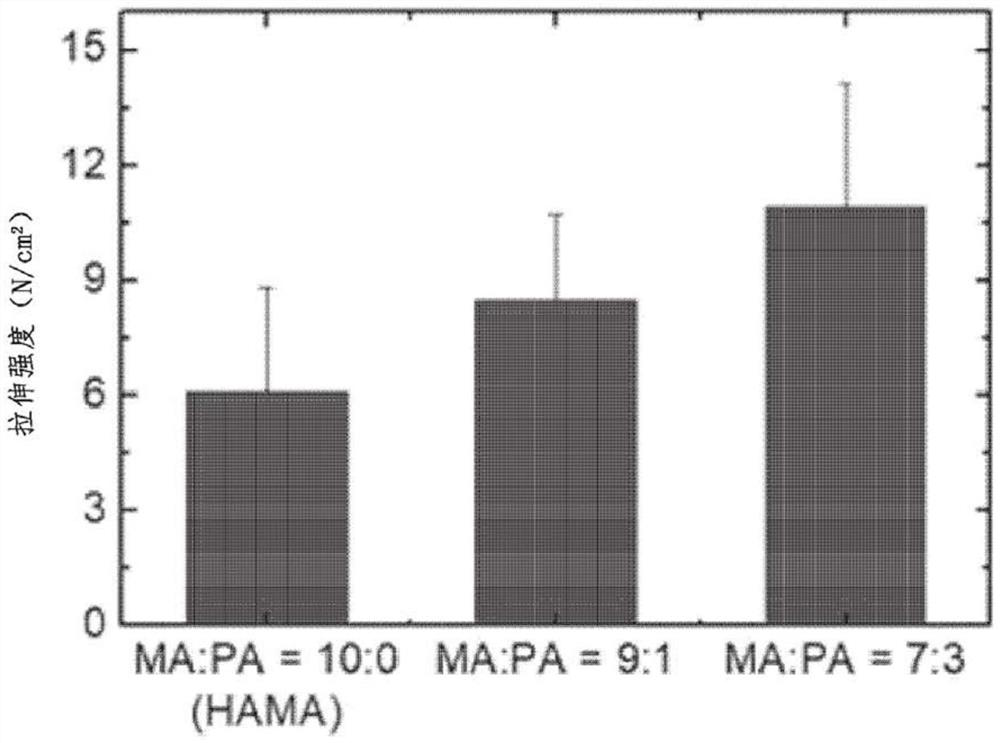Manufacture of photo-crosslinkable biodegradable tissue adhesives using copolymers
A tissue adhesive, biodegradable technology, applied in the field of tissue adhesives, can solve the problems of difficult physical properties, poor flexibility, control, etc.
- Summary
- Abstract
- Description
- Claims
- Application Information
AI Technical Summary
Problems solved by technology
Method used
Image
Examples
Embodiment 1
[0067] Example 1: Analysis of mechanical strength and flexibility of HAMA-co-HAPA
[0068] The tensile strength, tensile modulus, toughness and elongation of the HAMA-co-HAPA copolymer were measured by tensile test, wherein by changing the methacrylic anhydride and 4-pentane added in Synthesis Example 1 The HAMA-co-HAPA copolymer was synthesized with the ratio of alkene anhydride so that the ratios of HAMA and HAPA were 10:0, 9:1 and 7:3.
[0069] For the tensile test, a test piece molded in a dog bone shape was measured using AND's universal testing machine at a speed of 1 mm / min according to the ASTM method.
[0070] For tensile strength, the maximum stress is measured in the strain-stress curve, and for tensile modulus, the slope between stress and strain rate is measured. Toughness is analyzed by integrating the total area up to the breaking point of the sample, and elongation is analyzed by measuring the strain rate at the breaking point.
[0071] The result is as figu...
Embodiment 2
[0075] Example 2: Analysis of Adhesive Properties of HAMA-co-HAPA
[0076] In order to evaluate the adhesive properties of the HAMA-co-HAPA copolymer prepared in Synthesis Example 1, a Lap shear test of the HAMA-co-HAPA copolymer was carried out, in which, by changing the added formazan HAMA-co-HAPA was synthesized by mixing ratio of acrylic anhydride and 4-pentenoic anhydride (10:0 to 9:1).
[0077] After applying the HAMA-co-HAPA solution into the artificial skin made of gelatin, ultraviolet rays were irradiated for 5 seconds, and the adhesion was evaluated by pulling both ends simultaneously.
[0078] The result is as image 3 As shown, the HAMA-co-HAPA copolymer exhibits higher adhesion than the HAMA single polymer, which is due to the improved mechanical properties.
PUM
 Login to View More
Login to View More Abstract
Description
Claims
Application Information
 Login to View More
Login to View More - R&D
- Intellectual Property
- Life Sciences
- Materials
- Tech Scout
- Unparalleled Data Quality
- Higher Quality Content
- 60% Fewer Hallucinations
Browse by: Latest US Patents, China's latest patents, Technical Efficacy Thesaurus, Application Domain, Technology Topic, Popular Technical Reports.
© 2025 PatSnap. All rights reserved.Legal|Privacy policy|Modern Slavery Act Transparency Statement|Sitemap|About US| Contact US: help@patsnap.com



